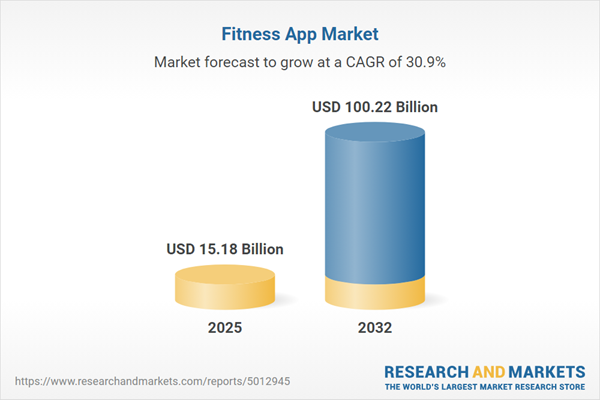Speak directly to the analyst to clarify any post sales queries you may have.
Senior executives are reevaluating corporate digital health offerings in response to rising compliance challenges and rapidly advancing technology. In the fitness app market, up-to-date intelligence enables organizations to make data-driven decisions, ensuring that wellness programs remain resilient, functional, and aligned with evolving workforce needs.
Market Snapshot: Fitness App Market Size, CAGR, and Forecast
The global fitness app market has become a key pillar of digital health ecosystems, with steady growth driven by enterprise adoption and individual engagement. In 2024, the sector reached a market value of USD 11.62 billion and is projected to achieve USD 15.18 billion in 2025. Forecasts indicate expansion to USD 100.22 billion by 2032, supported by a compound annual growth rate (CAGR) of 30.90%. For enterprises, integrating fitness platforms is accelerating both employee engagement strategies and new ways to address holistic wellness across organizations. Competition among established brands and evolving regulatory requirements have heightened the need for compliant, interoperable solutions, making procurement decisions more complex and strategic.
Scope & Segmentation
- Platforms: Android and iOS systems underpin most enterprise wellness initiatives, enabling broad access through preferred mobile devices, thus supporting engagement at all organizational levels.
- Subscription Models: Freemium and premium options give enterprises flexibility to align service features and analytics with specific business objectives and reporting mandates.
- Fitness Goals: Organizations implement fitness apps for use cases such as employee rehabilitation, weight management, wellness promotion, and strength building, supporting customized wellbeing objectives.
- Activity Types: Core offerings like cardio, strength training, high-intensity interval training (HIIT), yoga, and meditation promote a holistic approach to both physical and mental health.
- Regions: North America continues to drive large-scale adoption due to investment in productivity and robust infrastructure. Asia-Pacific shows accelerated uptake fueled by digital transformation, while Europe, Middle East, Africa, and Latin America display distinctive patterns reflecting unique compliance landscapes and workforce needs.
- Leading Companies: Major providers—including Apple Inc, Google LLC, Samsung Electronics Co., Ltd, Under Armour Inc, Strava Inc, Peloton Interactive Inc, Noom Inc, Fitbit Inc, Adidas AG, and Garmin Ltd—expand portfolios in alignment with emerging corporate wellbeing trends and strategic employee engagement priorities.
Key Takeaways: Fitness App Market Trends and Opportunities
- Artificial intelligence drives personalization within fitness apps, enhancing user experiences and optimizing engagement for improved organizational wellbeing.
- Gamification—through corporate challenges, rewards, and milestone tracking—sustains employee participation and enables measurable wellness program outcomes.
- Mental health tools and features are increasingly integrated, reflecting a shift towards holistic employee support, including stress management and psychological resilience.
- Collaborative development among app providers, device manufacturers, and healthcare organizations is advancing integrated digital health ecosystems and streamlining decision-making for enterprises.
- Enterprises emphasize robust data privacy, security, and compliance in response to varying regulatory requirements, especially when operations span multiple jurisdictions.
Tariff Impact on Fitness App Supply Chains and Pricing Strategies
Recent changes in U.S. tariffs have elevated hardware expenses, directly influencing device availability that supports enterprise fitness app functionality. Companies are meeting these challenges by diversifying supply sources and forging manufacturing partnerships across Southeast Asia and Eastern Europe. This strategy ensures consistent app performance and manages cost structures across corporate and consumer markets. As worldwide data regulations evolve, enterprises are also investing in regional data hosting and adapting commercial agreements to maintain compliance while ensuring uninterrupted service delivery.
Methodology & Data Sources
The findings in this report are informed by structured interviews with industry leaders, product benchmarking, and demographic research. All insights are cross-validated with leading market intelligence sources and official industry documentation, ensuring reliability and relevance for executive decision-making.
Why This Report Matters
- Supports leadership teams in optimizing digital wellness programs and evaluating technology partnerships in a developing market landscape.
- Provides segmented analysis that informs enterprise investment strategies and compliance planning for diverse regional operations.
- Guides the development of health models that balance evolving regulatory needs and organizational wellbeing objectives globally.
Conclusion
Focused insights into the fitness app market position enterprises to strengthen their workforce wellbeing programs and proactively address changing demands within digital health. This report empowers senior leadership to drive strategies that deliver resilience and measurable outcomes.
Additional Product Information:
- Purchase of this report includes 1 year online access with quarterly updates.
- This report can be updated on request. Please contact our Customer Experience team using the Ask a Question widget on our website.
Table of Contents
3. Executive Summary
4. Market Overview
7. Cumulative Impact of Artificial Intelligence 2025
Companies Mentioned
The companies profiled in this Fitness App market report include:- Apple Inc
- Google LLC
- Samsung Electronics Co., Ltd
- Under Armour, Inc
- Strava, Inc
- Peloton Interactive, Inc
- Noom, Inc
- Fitbit, Inc
- Adidas AG
- Garmin Ltd
Table Information
| Report Attribute | Details |
|---|---|
| No. of Pages | 181 |
| Published | November 2025 |
| Forecast Period | 2025 - 2032 |
| Estimated Market Value ( USD | $ 15.18 Billion |
| Forecasted Market Value ( USD | $ 100.22 Billion |
| Compound Annual Growth Rate | 30.9% |
| Regions Covered | Global |
| No. of Companies Mentioned | 11 |









